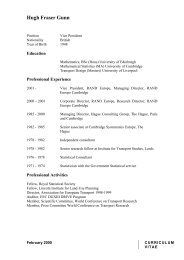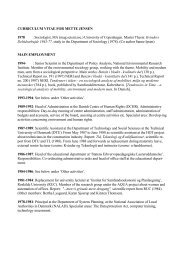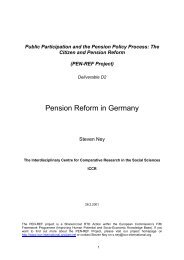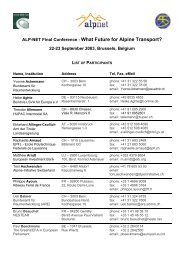The Housing Dimension of Welfare Reform - the ICCR
The Housing Dimension of Welfare Reform - the ICCR
The Housing Dimension of Welfare Reform - the ICCR
Create successful ePaper yourself
Turn your PDF publications into a flip-book with our unique Google optimized e-Paper software.
Pure crowding or affordability problems are relatively rare and a<br />
substantial part <strong>of</strong> <strong>the</strong> population is faced with a cumulative lack <strong>of</strong><br />
housing integration across dimensions. In Italy four per cent <strong>of</strong> <strong>the</strong><br />
population is at extreme risk <strong>of</strong> non-integration in all domains.<br />
3.3.4 Pathways to exclusion, housing stress and main risk groups<br />
Low income and risk <strong>of</strong> poverty<br />
A person is characterised as <strong>of</strong> low income if he or she lives in household<br />
that earns less than 75 per cent <strong>of</strong> <strong>the</strong> population <strong>of</strong> a country. A person is<br />
said to be at risk <strong>of</strong> income poverty if he or she is found below <strong>the</strong> 60 per<br />
cent <strong>of</strong> <strong>the</strong> median equivalised income <strong>of</strong> <strong>the</strong> population in that country.<br />
In 1997 one in six <strong>of</strong> European citizens lived in households with<br />
economic resources below <strong>the</strong> at-risk-<strong>of</strong>-poverty threshold. <strong>The</strong> variation<br />
across European countries is quite significant, ranging from one in twelve<br />
in Denmark to one in five in <strong>the</strong> UK.<br />
<strong>The</strong> financial means <strong>of</strong> persons in economically inactive households who<br />
are not retired are significantly below <strong>the</strong> national average. It is not<br />
surprisingly <strong>the</strong>refore that <strong>the</strong>se groups face also an over-proportional<br />
risk <strong>of</strong> income poverty: members <strong>of</strong> unemployed households experience<br />
income poverty roughly three times as <strong>of</strong>ten as, for instance, members <strong>of</strong><br />
households where at least one working person is present.<br />
In most countries <strong>the</strong> risk <strong>of</strong> poverty increases with <strong>the</strong> number <strong>of</strong><br />
children. If <strong>the</strong> number <strong>of</strong> children exceeds two or if only one parent is<br />
present, <strong>the</strong> risk <strong>of</strong> falling below <strong>the</strong> poverty threshold is high. Inevitably<br />
this has consequences also for <strong>the</strong> scope <strong>of</strong> child poverty. Only in<br />
Greece, Denmark and Finland is <strong>the</strong> risk <strong>of</strong> income poverty for large<br />
families below <strong>the</strong> population average. Denmark and Finland, on <strong>the</strong><br />
o<strong>the</strong>r hand, display comparatively lower poverty risks for single parent<br />
households.<br />
Elderly single households in <strong>the</strong> EU (which are mostly widows) find<br />
<strong>the</strong>mselves almost as <strong>of</strong>ten in a state <strong>of</strong> at-risk-<strong>of</strong> income poverty as<br />
persons who live in large families. Only in Spain and <strong>the</strong> Ne<strong>the</strong>rlands are<br />
persons over <strong>the</strong> age <strong>of</strong> 65 relatively well protected from poverty risk. In<br />
most o<strong>the</strong>r countries <strong>the</strong>ir poverty risk is increased by at least one third<br />
against <strong>the</strong> national average.<br />
Also particularly vulnerable to income poverty are migrants and<br />
especially those from non-EU countries <strong>of</strong> origin. Despite a wide margin<br />
<strong>of</strong> statistical error which is associated with <strong>the</strong> poverty rates <strong>of</strong><br />
EUROHOME-IMPACT FINAL REPORT 35









